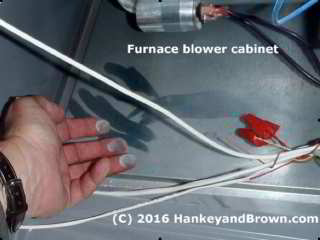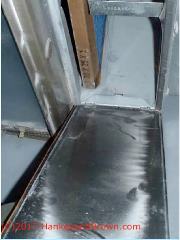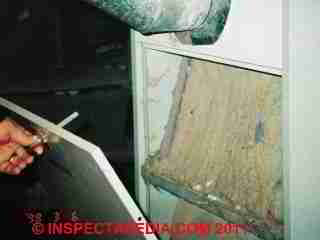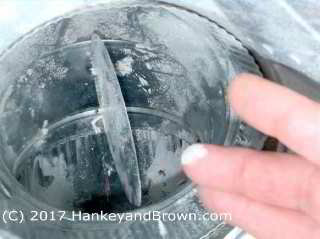 Drywall Dust Contamination of HVAC
Drywall Dust Contamination of HVAC
- POST a QUESTION or COMMENT about dust contamination of HVAC systems
Dust-contaminated HVAC systems:
This article describes drywall dust or construction dust contamination of air conditioning or heating system air handlers.
Minnesota home inspector Roger Hankey describes the causes and effects of dust contamination in HVAC systems that occurs particularly when the air handler is operated during construction such as as a space heater or as an air conditioner during drywall installation and taping.
InspectAPedia tolerates no conflicts of interest. We have no relationship with advertisers, products, or services discussed at this website.
Wallboard Joint Dust and Forced Air Heating & Cooling Systems
 Residential forced air heating, ventilating, and cooling systems (HVAC) are not intended to be used during construction, especially during sanding of the gypsum wallboard joints. We have inspected new houses where the system was contaminated with wallboard dust. We have also found this condition in remodeled older houses.
Residential forced air heating, ventilating, and cooling systems (HVAC) are not intended to be used during construction, especially during sanding of the gypsum wallboard joints. We have inspected new houses where the system was contaminated with wallboard dust. We have also found this condition in remodeled older houses.
In the photo at page top as well as shown here we see thick drywall dust deposits inside the air handler of a new forced-warm-air furnace.
[Click to enlarge any image]
Wallboard joint dust contains fine particles and is airborne unless special joint compound and ventilation measures are used. If the HVAC system is not completely sealed during construction, dust can coat the blower, heat exchangers, cooling coil, and ducts, since most furnace filters (if present) either don’t capture the fine particles, or collapse from excessive dust.
Wallboard dust is an eye and lung irritant. Material safety data sheets caution workers to protect their eyes and lungs against exposure to the dust. HVAC equipment manufacturers warn dust can adversely affect their equipment, including reducing efficiency and life span. Cleaning wallboard dust from HVAC equipment is difficult, costly, and cannot restore equipment to new condition.
Also, HVAC equipment manufacturers warn against using the system during construction as equipment may be subjected to abnormal operating conditions. Continuous furnace operation to cure wallboard joint compound can heat stress equipment. Also, if the filter is clogged, air flow for proper heat transfer will be limited. This causes the high temperature limit switch to cycle equipment on and off, placing abnormal stress on the heat exchanger. Further, dust can damage blower motor bearings.
Canadian gas heating equipment manufacturers have put Canadian home builders on notice that as of May 2017 their installation instructions will prohibit use of their equipment as construction heaters.
Canadian manufacturers explain their decision on pages 2-3 of a document at:
https://www.chbaalberta.ca/uploads/files/Gas%20Furnace%20for%20Construction%20Heat-April%2025%2016%20003.pdf
US manufacturers have not banned use of their equipment during construction, but most US installation instructions are similar to the following: (author’s highlights)
Use of Furnace as Construction Heater
Lennox does not recommend the use of SL280UHV units as a construction heater during any phase of construction.
Very low return air temperatures, harmful vapors and operation of the unit with clogged or misplaced filters will damage the unit.
SL280UHV units may be used for heating of buildings or structures under construction, if the following conditions are met:
The vent system must be permanently installed per these installation instructions.
A room thermostat must control the furnace. The use of fixed jumpers that will provide continuous heating is not allowed.
The return air duct must be provided and sealed to the furnace. Return air temperature range between 60°F (16°C) and 80°F (27°C) must be maintained.
Air filters must be installed in the system and must be maintained during construction.
Air filters must be replaced upon construction completion.
The input rate and temperature rise must be set per the furnace rating plate.
One hundred percent (100%) outdoor air must be provided for combustion air requirements during construction. Temporary ducting may supply outdoor air to the furnace. Do not connect duct directly to the furnace. Size the temporary duct following these instructions in section for Combustion, Dilution and Ventilation Air in a confined space with air from outside.
The furnace heat exchanger, components, duct system, air filters and evaporator coils must be thoroughly cleaned following final construction cleanup.
All furnace operating conditions (including ignition, input rate, temperature rise, and venting) must be verified according to these installation instructions.” - source cited atReferences or Citations
Above: drywall dust is also visible inside the metal ductwork of the system shown here.
Installations of new or replacement furnaces are required to be permitted and inspected in Minnesota jurisdictions that enforce the State Mechanical Code.
The authority for requiring the system to be clean comes from the Minnesota State Mechanical code which reads as follows:
1346.0103 MAINTENANCE.
Mechanical systems, both existing and new, and parts of those systems, shall be maintained in proper operating condition in accordance with the original design and in a safe and sanitary condition. Devices or safeguards which are required by this code shall be maintained in compliance with the code edition under which they were installed.
The owner or the owner's designated agent shall be responsible for maintenance of mechanical systems. To determine compliance with this provision, the building official shall have the authority to require a mechanical system to be re-inspected.
The 2012 International Mechanical Code section 304 Installation, states:
304.1 General
“Equipment and appliances shall be installed as required by the terms of their approval, in accordance with the conditions of the listing, the manufacturer's installation instructions and this code. Manufacturer's installation instructions shall be available on the job site at the time of inspection.”
Recommendation for new house purchasers:
- If the purchase contract is to be signed PRIOR to construction, have a qualified attorney review the contract and include language to state that the purchaser is entitled to a HVAC system that was NOT used during construction and is free of construction dust and debris. Similar legal review is recommended prior to signing a purchase agreement for a recently completed new home including steps 2 & 3 below.
- Have a qualified independent inspector or HVAC contractor examine the system prior to the closing to determine if the system was in use during construction and if it is free of dust and debris.
- If the system has dust and debris, or has other signs of use during construction, have the attorney take steps to enforce contract provisions to replace all contaminated and/or used system components.
Buyers and inspectors are advised to obtain the furnace installation manual. Read the section on use during construction and the limitations section of the warranty. These provisions will be your support for objecting to any dust found in the furnace.
The same approach is recommended for purchasers of remodeled existing houses, or “flipped”, if the HVAC system is coated with drywall dust.
Similar agreements and provisions are recommended for home owners working with remodeling contractors to protect the HVAC system prior to remodeling or additions.
©2017 HankeyandBrown.com & InspectApedia.com (used with permission) All rights reserved.
Generalizing: dust contamination of HVAC systems
 Drywall-dust contamination inside of an air handler in new construction is a specific case of a more general problem with sources of contamination in HVAC systems, air handlers, ductwork and related components.
Drywall-dust contamination inside of an air handler in new construction is a specific case of a more general problem with sources of contamination in HVAC systems, air handlers, ductwork and related components.
For example operating air handlers for either heating or cooling during a mold remediation project (or before a mold remediation project if the situation is bad) can produce other contamination and health hazards, and depending on the type of ductwork the cleaning or repair cost in both cases can be quite high.
- Dust and debris may block the cooling coil in an air handler used for air conditioning, causing coil icing, blocked air flow, higher operating cost.
See DIRTY COOLING COIL / EVAPORATOR COIL
and
See FROST BUILD-UP on AIR CONDITIONER COILS - Dust and debris clogged air filters reduce air flow rate and can cause cooling coil icing in an air conditioning system or overheating of forced air heating systems
See DIRTY AIR FILTER PROBLEMS - There are also some more subtle air flow issues that many inspectors including HVAC technicians miss: I [DJF] have found by actual measurement that there can be a very high difference, more than 50% change in the CFM output of a squirrel cage blower when we remove dust and debris from those concave blades of the blower cage. Thorough cleaning is a bit of work involving some disassembly to do the job well - that's rarely done.
Roger Hankey is principal of Hankey and Brown Inspections, Winter Park, CO. Mr. Hankey is a past chairman of the ASHI Standards Committee and served in other ASHI chapter and national leadership roles. Mr. Hankey is a National Radon Proficiency Program certified measurement professional and a Level II infrared thermographer. Contact Roger Hankey at: 970-393-6604 - rogerhankey47@gmail.com . Website: www.HankeyandBrown.com Mr. Hankey is a frequent contributor to InspectAPedia.com.
Reader Comments, Questions & Answers About The Article Above
Below you will find questions and answers previously posted on this page at its page bottom reader comment box.
Reader Q&A - also see RECOMMENDED ARTICLES & FAQs
On 2022-12-11 by InspectApedia (Editor)
@Bsj,
We are glad to assist; let us know what you find - that may help other readers.
Also be sure to review the discussion in the article above on this page
and
PLASTER DUST EXPOSURE HEALTH HAZARDS
On 2022-12-11 by Bsj
@InspectApedia (Editor), Thank you for your advise and thorough response. After meeting with a Pulmonologist, and gaining more information, this advise will be helpful if we decide to bring in a neutral party to test some samples.
True, "beleifs" are not facts and "may have caused" implies that we don't know the answers yet.
Thanks again, very much appreciate your insight.
On 2022-12-11 by InspectApedia (Editor) - dust from drywall in the ductwork
@Bsj,
About your last question, "Isn't it reasonable that home owners should be able to move in without fear of contracting a disease from their home's environment?"
my OPINION is that of course the answer is yes, but I recommend that you take care not to pose questions that presume an answer (that your building was improperly-built or improperly-cleaned and is guilty of causing health issues) before we know the facts.
There are several questions to be answered here:
1. Is there or was there a harmful dust or other contaminant in your home - of which you suspect drywall dust.
See DUST SAMPLING PROCEDURE for an easy, inexpensive way to collect samples of settled dust in buildings. Those tape samples can be sent to any environmental test lab who agrees that their technicians and procedures can identify the dominant and harmful particles in building dust.
2. Could that dust explain the serious health issues to which you refer: either as a cause or as an exacerbating effect (making things worse), specifically drywall dust?
Start by finding a doctor whom you trust; bring your questions to your doctor and follow her advice.
3. What has been the level of exposure of building occupants to that dust: level and duration of exposure?
This may be impossible to say with confidence, depending on what an independent expert finds are the present levels of building contaminants.
Watch out: Even if your doctor agrees that environmental contaminants in your building could cause or contribute to illness, don't assume, without more guidance from your doctor, that you have correctly identified the culprit as drywall dust.
4. What are the specific health vulnerabilities of building occupants to the contaminant in question.
Again this is a question for your doctors.
5. Is it possible for building environmental samples collected now, five years after first occupancy of the building, to give evidence of the history of the level of exposure of building occupants to the dust.
This is a question to discuss with an independent environmental inspection and testing expert. In my opinion I would never rely simply on someone who stops by to collect a few environmental samples to send to a lab.
A more reliable assessment of building environmental hazards requires an experienced professional's eye and judgement, a thorough inspection of the building, a review of its history, including leaks, uses of chemicals and pesticides, and similar concerns, and an interview of building occupants to understand their health vulnerabilities and concerns.
This EXPERTS DIRECTORY may be of some help.
6. Are there other building conditions or contaminants that contribute to the occupants' health concerns and which of all of those are most-important.
In my OPINION I'm doubtful of the reliability of current samples of settled-dust and certainly not air samples of the level of airborne dust to give an accurate estimate of the building's contribution to or cause of health issues without a lot more specific data, unless (and this is certainly possible) current environmental inspection and tests of your building find significant levels of one or more contaminants.
A high level of contaminants present now that can be traced back to original construction might then give an answer to your question.
On 2022-12-11 by Bsj
I believe our builder left all kinds of dust from drywall, tile etc. in the ductwork in our new ohio home. We have lived there for 5 years. I beleive it may have caused serious health issues.
Can you recommend a way to have it tested for silica? Isn't it reasonable that home owners should be able to move in without fear of contracting a disease from their home's environment?
...
Continue reading at AIRBORNE PARTICLE & MOLD LEVELS in DUCTWORK or select a topic from the closely-related articles below, or see the complete ARTICLE INDEX.
Or see
Recommended Articles
Suggested citation for this web page
AIR HANDLER DUST CONTAMINATION at InspectApedia.com - online encyclopedia of building & environmental inspection, testing, diagnosis, repair, & problem prevention advice.
Or see this
INDEX to RELATED ARTICLES: ARTICLE INDEX to HVAC DUCT SYSTEMS
Or use the SEARCH BOX found below to Ask a Question or Search InspectApedia
Ask a Question or Search InspectApedia
Try the search box just below, or if you prefer, post a question or comment in the Comments box below and we will respond promptly.
Search the InspectApedia website
Note: appearance of your Comment below may be delayed: if your comment contains an image, photograph, web link, or text that looks to the software as if it might be a web link, your posting will appear after it has been approved by a moderator. Apologies for the delay.
Only one image can be added per comment but you can post as many comments, and therefore images, as you like.
You will not receive a notification when a response to your question has been posted.
Please bookmark this page to make it easy for you to check back for our response.
Our Comment Box is provided by Countable Web Productions countable.ca
Citations & References
In addition to any citations in the article above, a full list is available on request.
- Lennox Furnace Install Manual, Document 506763−01, Issued 06/2011, Supersedes 03/2011, Lennox furnace install manual. INSTALLATION INSTRUCTIONS SL280UHV, Page 5, Use of furnace as construction heater, Tel: Lennox at (800) 453-6669 options 2,2,2 John, Call made to 800 453 6669, March 7, 2017 8:30 CST Lennox Tech. Support states this is current policy. OK to quote in article. NTF by private email from Roger Hankey, 2017/03/07
- Our recommended books about building & mechanical systems design, inspection, problem diagnosis, and repair, and about indoor environment and IAQ testing, diagnosis, and cleanup are at the InspectAPedia Bookstore. Also see our Book Reviews - InspectAPedia.
- In addition to citations & references found in this article, see the research citations given at the end of the related articles found at our suggested
CONTINUE READING or RECOMMENDED ARTICLES.
- Carson, Dunlop & Associates Ltd., 120 Carlton Street Suite 407, Toronto ON M5A 4K2. Tel: (416) 964-9415 1-800-268-7070 Email: info@carsondunlop.com. Alan Carson is a past president of ASHI, the American Society of Home Inspectors.
Thanks to Alan Carson and Bob Dunlop, for permission for InspectAPedia to use text excerpts from The HOME REFERENCE BOOK - the Encyclopedia of Homes and to use illustrations from The ILLUSTRATED HOME .
Carson Dunlop Associates provides extensive home inspection education and report writing material. In gratitude we provide links to tsome Carson Dunlop Associates products and services.


